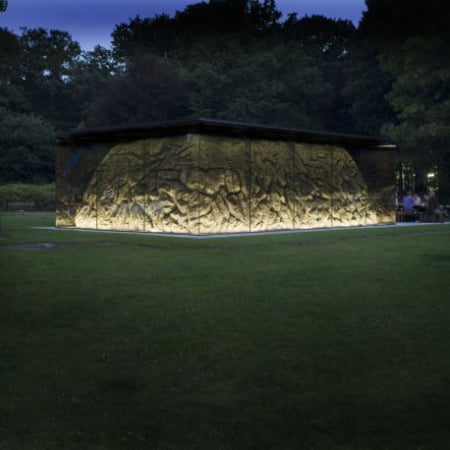This cave inside a glass box is a pavilion in Tilburg, Netherlands, by Melbourne designer Callum Morton.
Called Grotto, the structure is located at the point where eight paths converge in a baroque formal garden.
It is clad in one-way glass to reflect the surrounding park during the day, but is illuminated from within at night to reveal the rock-like structure inside.
The interior is sunk into the ground and has holes at eye level to afford glimpses of the park outside.
The pavilion was furnished by Netherlands designer Olav Koreman.
See also: Dezeen's top ten pavilions.
The text that follows is from Morton:
In 2007 Fundament Foundation commissioned Callum Morton to design a pavilion for De Oude Warande. If the baroque design of the garden was to be respected, it had to be at the central point of the park, the only spot from where the star-shaped pattern of the paths can be seen.
However, a pavilion in this position would destroy the view of the star design. This presented Morton with a dilemma, which he resolved in a way that was both simple and ingenious: he designed an invisible pavilion.
The exterior is not immediately apparent, because it is a mirror, so all eight paths of the star continue in the reflection. The exterior of the pavilion functions both as a façade, screening off the inside from the outside, and as a reflective screen, mirroring and continuing the outside world. However, this continuation is an illusion. The baroque design only appears to remain in view.
Anyone who steps inside the pavilion (10m x 6m x 4m high) is confronted with another essential characteristic of baroque garden designs. The interior is a cave-like space, sunk 75 centimetres below ground level. Walls have holes at eye level, through which the outside world can be seen, as the glass façade is made of two-way mirrors. In the evening, the interior is illuminated in such a way that the reflective function of the pavilion is cancelled out and the glass box makes place for a dark mound, reminiscent of a burial mound. This transformation takes place gradually as darkness falls, so that the pavilion not only has a constantly changing form but alternate meanings too.
Grotto is a baroque folly, a screen, a cave, a grave and a functional pavilion. Callum Morton’s thinking was guided by baroque notions, the principles of contemporary entertainment, the human habit of looking for a place to be together with someone else, and the desire to produce an exciting tension between interior and exterior. “In the first instance, I wanted to develop a design that would clash with the Baroque layout of De Oude Warande,” says Morton. “But now I think it clashes with itself. Grotto is a paradox.” Outside of concert times, Grotto will function as a pavilion with modest catering facilities.
The kitchen and furniture are by designer Olav Koreman (Breda, 1959, lives and works in Molenschot and Breda), in a typically Dutch tradition (De Stijl), but also with references to Minimal Art of artists including Sol LeWitt. Using minimal means, Koreman has achieved maximum effect both inside and outside, while at the same time leaving the complex character of Grotto completely intact.

